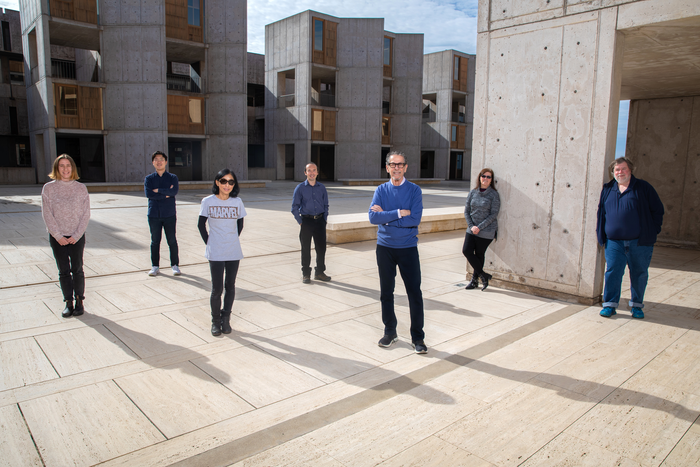LA JOLLA—(January 4, 2022) The discovery of insulin 100 years ago opened a door that would lead to life and hope for millions of people with diabetes. Ever since then, insulin, produced in the pancreas, has been considered the primary means of treating conditions characterized by high blood sugar (glucose), such as diabetes. Now, Salk scientists have discovered a second molecule, produced in fat tissue, that, like insulin, also potently and rapidly regulates blood glucose. Their finding could lead to the development of new therapies for treating diabetes, and also lays the foundation for promising new avenues in metabolism research.

Credit: Salk Institute
LA JOLLA—(January 4, 2022) The discovery of insulin 100 years ago opened a door that would lead to life and hope for millions of people with diabetes. Ever since then, insulin, produced in the pancreas, has been considered the primary means of treating conditions characterized by high blood sugar (glucose), such as diabetes. Now, Salk scientists have discovered a second molecule, produced in fat tissue, that, like insulin, also potently and rapidly regulates blood glucose. Their finding could lead to the development of new therapies for treating diabetes, and also lays the foundation for promising new avenues in metabolism research.
The study, which was published in Cell Metabolism on January 4, 2022, shows that a hormone called FGF1 regulates blood glucose by inhibiting fat breakdown (lipolysis). Like insulin, FGF1 controls blood glucose by inhibiting lipolysis, but the two hormones do so in different ways. Importantly, this difference could enable FGF1 to be used to safely and successfully lower blood glucose in people who suffer from insulin resistance.
“Finding a second hormone that suppresses lipolysis and lowers glucose is a scientific breakthrough,” says co-senior author and Professor Ronald Evans, holder of the March of Dimes Chair in Molecular and Developmental Biology. “We have identified a new player in regulating fat lipolysis that will help us understand how energy stores are managed in the body.”
When we eat, energy-rich fats and glucose enter the bloodstream. Insulin normally shuttles these nutrients to cells in muscles and fat tissue, where they are either used immediately or stored for later use. In people with insulin resistance, glucose is not efficiently removed from the blood, and higher lipolysis increases the fatty acid levels. These extra fatty acids accelerate glucose production from the liver, compounding the already high glucose levels. Moreover, fatty acids accumulate in organs, exacerbating the insulin resistance—characteristics of diabetes and obesity.
Previously, the lab showed that injecting FGF1 dramatically lowered blood glucose in mice and that chronic FGF1 treatment relieved insulin resistance. But how it worked remained a mystery.
In the current work, the team investigated the mechanisms behind these phenomena and how they were linked. First, they showed that FGF1 suppresses lipolysis, as insulin does. Then they showed that FGF1 regulates the production of glucose in the liver, as insulin does. These similarities led the group to wonder if FGF1 and insulin use the same signaling (communication) pathways to regulate blood glucose.
It was already known that insulin suppresses lipolysis through PDE3B, an enzyme that initiates a signaling pathway, so the team tested a full array of similar enzymes, with PDE3B at the top of their list. They were surprised to find that FGF1 uses a different pathway—PDE4.
“This mechanism is basically a second loop, with all the advantages of a parallel pathway. In insulin resistance, insulin signaling is impaired. However, with a different signaling cascade, if one is not working, the other can. That way you still have the control of lipolysis and blood glucose regulation,” says first author Gencer Sancar, a postdoctoral researcher in the Evans lab.
Finding the PDE4 pathway opens new opportunities for drug discovery and basic research focused on high blood glucose (hyperglycemia) and insulin resistance. The scientists are eager to investigate the possibility of modifying FGF1 to improve PDE4 activity. Another route is targeting multiple points in the signaling pathway before PDE4 is activated.
“The unique ability of FGF1 to induce sustained glucose lowering in insulin-resistant diabetic mice is a promising therapeutic route for diabetic patients. We hope that understanding this pathway will lead to better treatments for diabetic patients,” says co-senior author Michael Downes, a senior staff scientist in the Evans lab. “Now that we’ve got a new pathway, we can figure out its role in energy homeostasis in the body and how to manipulate it.”
Other authors included Sihao Liu, Emanuel Gasser, Jacqueline G. Alvarez, Christopher Moutos, Kyeongkyu Kim, Yuhao Wang, Timothy F. Huddy, Brittany Ross, Yang Dai, David Zepeda, Brett Collins, Emma Tilley, Matthew J. Kolar, Ruth T. Yu, Annette R. Atkins and Alan Saghatelian of Salk; Tim van Zutphen, Theo H. van Dijk and Johan W. Jonker of the University of Groningen, in the Netherlands.
The research was supported by the National Institutes of Health, the Nomis Foundation, the March of Dimes, Deutsche Forschungsgemeinschaft (DFG), Netherlands Organization for Scientific Research, the European Foundation for the Study of Diabetes and the Swiss National Science Foundation.
About the Salk Institute for Biological Studies:
Every cure has a starting point. The Salk Institute embodies Jonas Salk’s mission to dare to make dreams into reality. Its internationally renowned and award-winning scientists explore the very foundations of life, seeking new understandings in neuroscience, genetics, immunology, plant biology and more. The Institute is an independent nonprofit organization and architectural landmark: small by choice, intimate by nature and fearless in the face of any challenge. Be it cancer or Alzheimer’s, aging or diabetes, Salk is where cures begin. Learn more at: salk.edu.
Journal
Cell Metabolism
DOI
10.1016/j.cmet.2021.12.004
Article Title
FGF1 and insulin control lipolysis by convergent pathways
Article Publication Date
4-Jan-2022




